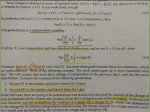You are using an out of date browser. It may not display this or other websites correctly.
You should upgrade or use an alternative browser.
You should upgrade or use an alternative browser.
Var(nX) = n^2Var(X) or nVar(X) ?
- Thread starter Peacock
- Start date
Dr.Peterson
Elite Member
- Joined
- Nov 12, 2017
- Messages
- 16,873
Attached is a picture of a textbook. I do not understand the differences between the yellow highlights and the orange highlights. It seems like both are Var(sum of n Xs). How then could one result in an n^2 coefficient and the other an n?
I think they explain the difference very nicely, except at the end. Possibly the similarity of "variance" and "variation" makes it easy to misread the next to last sentence. Unfortunately, they skipped the details of why n is squared, trusting you to see it. The idea is that when you multiply a single random variable by 10, you are multiplying the deviation (that is, the amount by which it varies from the mean) by 10; but the variance is defined as the expectation of the square of the deviation, and therefore is squared!
Is that enough to help you out?
The other issue is that the two situations are not "both ... Var(sum of n Xs)". One is the sum of n independent random variables, and the other is a multiple of a single random variable. This is the part that they do explain well, I think.
Thanks for your reply, Dr. Peterson.
I understand the difference between the two scenarios given. As you said, "One is the sum of n independent random variables (yellow), and the other is a multiple of a single random variable (orange)", which I understand.
However, I fail to understand the two functions which are inside the Var function. MATHEMATICALLY, how is 'nX' (orange) any different from 'sum(X)|from 1 to n' (yellow)? In my mind, both are the sum of n X's.
I understand the difference between the two scenarios given. As you said, "One is the sum of n independent random variables (yellow), and the other is a multiple of a single random variable (orange)", which I understand.
However, I fail to understand the two functions which are inside the Var function. MATHEMATICALLY, how is 'nX' (orange) any different from 'sum(X)|from 1 to n' (yellow)? In my mind, both are the sum of n X's.
Dr. Peterson, sorry to duplicate my replies. However, I fear that since I did not reply directly to your post you were not notified of my response. Please see my reply dated 04-21-2018, 03:58 PM. Thank you.
I think they explain the difference very nicely, except at the end. Possibly the similarity of "variance" and "variation" makes it easy to misread the next to last sentence. Unfortunately, they skipped the details of why n is squared, trusting you to see it. The idea is that when you multiply a single random variable by 10, you are multiplying the deviation (that is, the amount by which it varies from the mean) by 10; but the variance is defined as the expectation of the square of the deviation, and therefore is squared!
Is that enough to help you out?
The other issue is that the two situations are not "both ... Var(sum of n Xs)". One is the sum of n independent random variables, and the other is a multiple of a single random variable. This is the part that they do explain well, I think.

